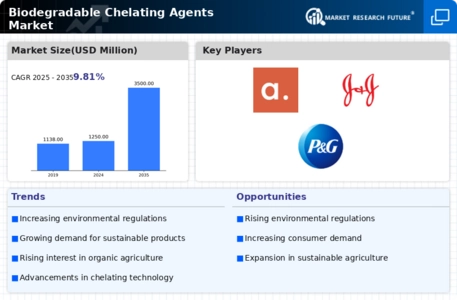Market Growth Projections
The Global Biodegradable Chelating Agents Market Industry is poised for substantial growth, with projections indicating a market size of 3500 USD Million by 2035. This growth is underpinned by a compound annual growth rate of 9.81% from 2025 to 2035, reflecting the increasing adoption of biodegradable solutions across various sectors. Factors such as rising environmental awareness, regulatory support, and technological advancements are contributing to this upward trajectory. The market's expansion is likely to be driven by innovations in product formulations and production processes, which will enhance the availability and effectiveness of biodegradable chelating agents.
Growing Demand in Agriculture
The agricultural sector's increasing reliance on sustainable practices is a key driver of the Global Biodegradable Chelating Agents Market Industry. Biodegradable chelating agents are gaining traction as they enhance nutrient availability and improve soil health without contributing to long-term environmental harm. This trend is particularly evident in organic farming, where the use of synthetic chemicals is minimized. As farmers seek effective and eco-friendly solutions, the demand for biodegradable chelating agents is expected to rise. This shift is anticipated to contribute to a compound annual growth rate of 9.81% from 2025 to 2035, reflecting the sector's commitment to sustainability.
Rising Environmental Awareness
The increasing global emphasis on sustainability and environmental protection drives the Global Biodegradable Chelating Agents Market Industry. Consumers and industries alike are becoming more conscious of the ecological impact of traditional chelating agents, which often contribute to pollution and environmental degradation. This shift in consumer behavior is prompting manufacturers to seek biodegradable alternatives that align with eco-friendly practices. As a result, the market is projected to reach 1250 USD Million in 2024, reflecting a growing demand for sustainable solutions. Companies are investing in research and development to create innovative biodegradable chelating agents that meet regulatory standards and consumer expectations.
Technological Advancements in Production
Innovations in the production processes of biodegradable chelating agents are propelling the Global Biodegradable Chelating Agents Market Industry forward. Advances in biotechnology and green chemistry are enabling manufacturers to develop more efficient and cost-effective methods for producing these agents. This not only enhances product quality but also reduces production costs, making biodegradable options more competitive against traditional chelating agents. As technology continues to evolve, the market is likely to experience accelerated growth, with projections suggesting a potential market size of 3500 USD Million by 2035. These advancements are crucial for meeting the rising demand for sustainable products across various industries.
Consumer Preference for Eco-Friendly Products
The shift in consumer preferences towards eco-friendly products is a significant driver of the Global Biodegradable Chelating Agents Market Industry. As awareness of environmental issues grows, consumers are increasingly opting for products that are not only effective but also sustainable. This trend is evident across various sectors, including personal care, cleaning, and agriculture, where biodegradable chelating agents are becoming preferred choices. Companies are responding to this demand by reformulating their products to include biodegradable ingredients, thereby enhancing their market appeal. This consumer-driven change is expected to contribute to the market's growth, with an anticipated increase to 1250 USD Million in 2024.
Regulatory Support for Biodegradable Solutions
Government regulations promoting the use of biodegradable materials significantly influence the Global Biodegradable Chelating Agents Market Industry. Many countries are implementing stricter environmental regulations that encourage the adoption of biodegradable alternatives in various applications, including agriculture, cleaning products, and industrial processes. These regulations not only aim to reduce environmental pollution but also support the development of green chemistry initiatives. As a result, the market is likely to expand, with projections indicating a growth trajectory that could see it reach 3500 USD Million by 2035. This regulatory landscape fosters innovation and investment in biodegradable chelating agents.







Leave a Comment